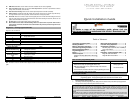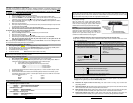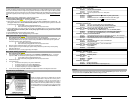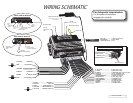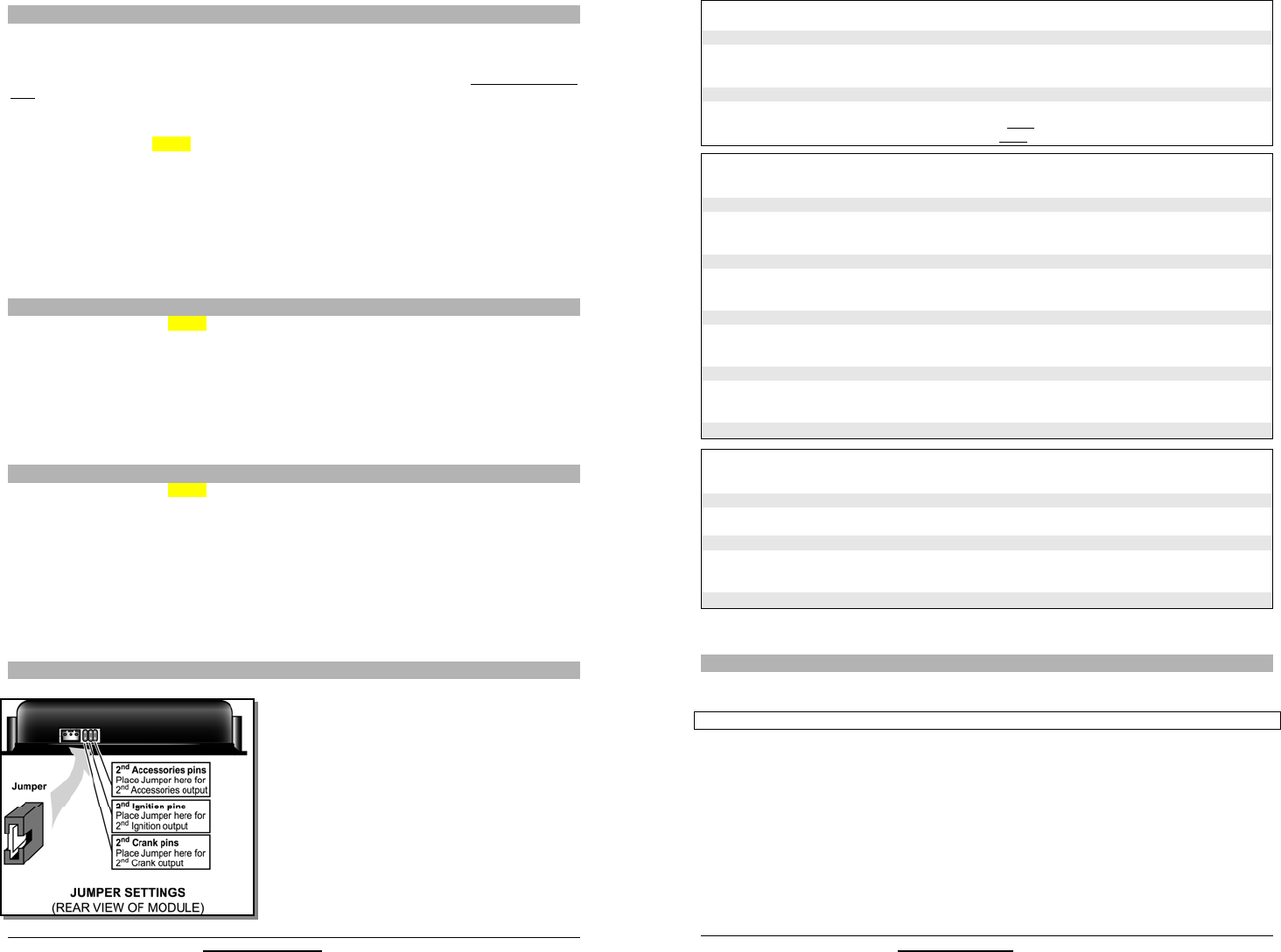
Installation Guide http://www.autostart.ca P. 3
OPTION 3 Passive arming (3 min.)
FUNCTION 4 – Door lock pulse timing
OPTION 1* 7/10-sec. lock / unlock pulses
OPTION 2 4-sec. lock / unlock pulses
OPTION 3 7/10-sec. lock pulse and two ¼ -sec. unlock pulses
FUNCTION 5 – LED flashing
OPTION 1* ENABLED (without starter kill
Æ
will flash only when ignition is OFF)
OPTION 2 DISABLED
OPTION 3 ENABLED (with starter kill Æ will ONLY flash when the starter kill engages.
This option should be selected ONLY if the starter kill is installed.)
MODE 2 (* indicates default setting)
FUNCTION 1 - Engine Run Time
OPTION 1 Run Time = 3 minutes in gas mode / 8 minutes diesel mode
OPTION 2* Run Time = 15 minutes in gas mode / 20 minutes diesel mode
OPTION 3 Run Time = 25 minutes in gas mode / 30 minutes diesel mode
FUNCTION 2 – Idle Mode & Turbo Mode (auto) / Turbo Mode (manual)
OPTION 1 Idle mode & turbo mode DISABLED (AUTO) / turbo mode DISABLED (MANUAL)
OPTION 2* Idle mode & turbo mode ENABLED (AUTO) / turbo mode DISABLED (MANUAL)
OPTION 3 Idle mode & turbo mode ENABLED (AUTO) / turbo mode ENABLED (MANUAL)
FUNCTION 3 – Engine type and Cold Weather Mode
OPTION 1 Diesel mode with 20-minute run time in cold weather mode (30-sec. wait to start delay)
OPTION 2* Gas mode with 3-minute run time in cold weather mode
OPTION 3 Diesel mode with 8-minute run time in cold weather mode (18-sec. wait to start delay)
FUNCTION 4 – AUX 1 programming
OPTION 1 Horn confirmation upon the 2
nd
press of the LOCK button
OPTION 2* Priority door access
OPTION 3 Horn confirmation upon the 1
st
press of the LOCK button.
FUNCTION 5 – Pager (Pager sold separately)
OPTION 1 Pager ENABLED
OPTION 2* Pager DISABLED
MODE 3 (* indicates default setting)
FUNCTION 1 – Ready Mode Option
OPTION 1 Enabled by handbrake
OPTION 2* Enabled by remote
FUNCTION 2 – Bypass
OPTION 1 ADS
OPTION 2* Xpresskit
OPTION 3 Fortin
FUNCTION 3 – Bypass Type
OPTION 1 One Way communication
OPTION 2* Two Way communication (For Xpresskit bypass only)
Bypass
Remote starters of this series have the ability to work in two way mode (D2D) with Xpresskit bypass modules. They also offer
one way communication with Xpresskit, ADS and Fortin brand bypass modules.
Note: For Hardware 5.0 and higher, there can only be one bypass connected to the unit.
P. 6 http://www.autostart.ca/ Installation Guide
Virtual Tach System
* Virtual Tach System combines the latest microcontroller technology and a complex algorithm that took years to develop.
VTS is able to effectively monitor the engine starting sequence and release the starter at the right time without physically
connecting the tach wire to the remote starter. The VTS constantly monitors the data and readjusts itself automatically in order
to maximize its capability to start the engine properly in any weather or deteriorating battery condition (automatic transmission
only).
Optional Time Delay Adjustment in Virtual Tach System
Follow these steps to program crank time adjustment, if needed:
1. Enter programming mode (page-1) the parking lights will stay on for up to 20 seconds.
2. Before the lights go out, press and hold the brake pedal and press the
LOCK and UNLOCK buttons simultaneously the
parking lights will flash 4 times. Do not release the brake pedal.Note: For vehicles that require the ignition to be turned ON
to activate the brake, follow these steps:
a. Turn the ignition ON; The parking lights will turn OFF
b. After 4 seconds the parking lights will turn ON and then press the brake.
3. Press the
LOCK button if you wish to increase the time delay or the UNLOCK button if you want to decrease it. The time
delay will be increased or decreased by 50ms. and the parking lights will flash once every time the
LOCK or UNLOCK
button is pressed.
4. Press the
TRUNK button to save the settings you have entered.
5. Release the brake pedal – the time delay programming is now complete.
Multi-speed Tach Programming
1) Enter programming mode (page-1) the parking lights will stay on for up to 20 seconds.
2) Before the lights go out, press and hold the brake pedal and press the
LOCK and UNLOCK buttons simultaneously the
parking lights will flash 4 times. At that point, release the brake pedal. Note: For vehicles that require the ignition to be
turned ON to activate the brake, follow these steps:
a) Turn the ignition ON; The parking lights will turn OFF
b) After 4 seconds the parking lights will turn ON and then press the brake.
3) Start up the engine and allow the vehicle to reach regular engine idle speed.
4) Once the engine is running at normal idle speed, press the brake pedal and keep it down until you hear the parking
lights output click 5 times.
5) Release the brake pedal the tach programming is now complete.
Horn Honk Timing adjustment
1) Enter programming mode (page-1)
2) Press and hold the brake pedal, then simultaneously press the UNLOCK and START/STOP buttons the horn will
chirp 5 times. Note: For vehicles that require the ignition to be turned ON to activate the brake, follow these steps:
a Turn the ignition ON; The parking lights will turn OFF
b After 4 seconds the parking lights will turn ON and then press the brake.
3) Release the brake pedal.
4) To change the timing:
x To increase the Horn pulse by 3 ms, press the
LOCK button.
x To decrease the pulse by 3 ms, press the
UNLOCK button.
x To increase the pulse by 10 ms, press the
START/STOP button.
x To decrease the pulse by 10 ms, press the
TRUNK button.
5) To save the new settings: press
LOCK and UNLOCK. If 3 chirps are returned, the new settings have been saved.
Supplementary Information
Fifth Relay Output (2nd IGN, ACC or CRANK)
Remote car starters of this series are equipped with an on-board
high-current programmable 5
th
relay that can be used to power a
second ignition, accessory or crank wire. The unit uses 3 sets of
pins; each set corresponds to a specific function of the output. In
order to activate one of the three possible functions, you must place
the jumper (supplied) on one of the three sets of pins and connect
the 14 AWG wire to the second IGN. / ACC. / CRANK wire of the
vehicle.



